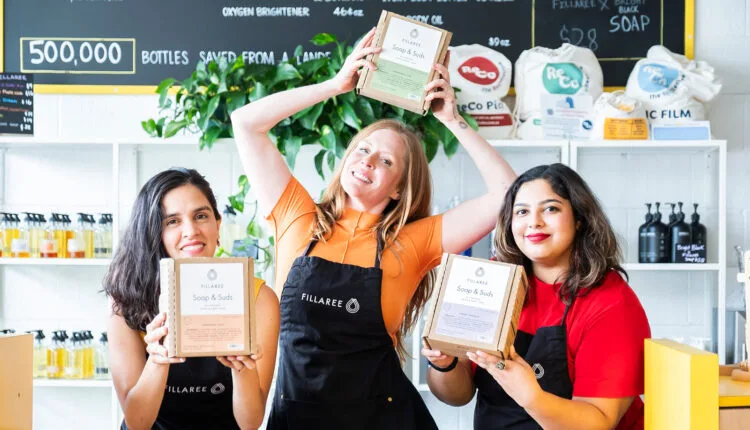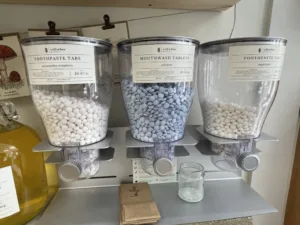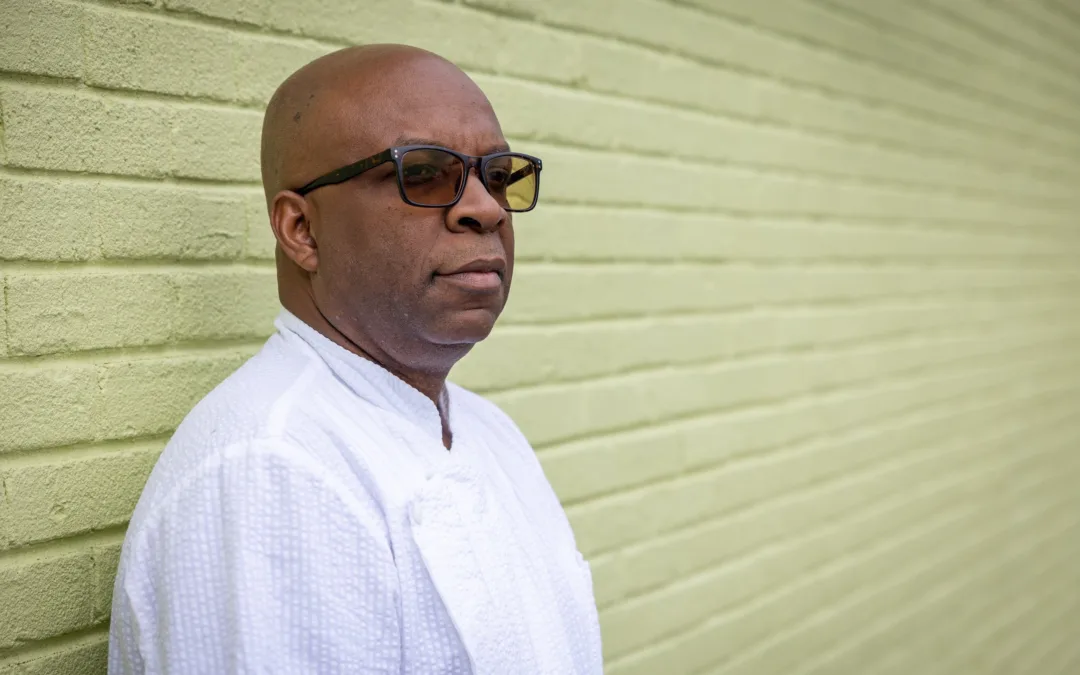
Fillaree employees courtesy of Sarai Cabera.
If you feel lied to about what happened to your “recycled” plastic (it probably wasn’t actually being recycled), refilleries are the answer. Here’s how to use them in NC.
Husband and wife team Mark and Sue Bayliff opened Fill-More, a refillery shop in downtown Burnsville, in 2018. Refilleries like Fill-More have popped up around the state to help consumers reduce the waste from plastic bottles holding cleaning products, laundry detergents, shampoos, body soaps, and more.
“Instead of getting single-use plastic containers every time you need your day-to-day supplies for your household or bath and body,” Sue explains, “you use the same container to refill products cutting down on the plastic waste you are creating.”
The Fill-More owners have been impressed with their customers’ commitment to a zero-waste lifestyle. One woman has brought a duct-taped cottage cheese container to fill with laundry detergent for the past four years.
Sue doesn’t expect people to be perfect — she just wants more people to make little changes.
“There needs to be millions of us doing better,” she says, “doing the best that we can.”

Inside Fill-More, courtesy of Sue Bayliff.
Why refilleries are important
Sue remembers the start of recycling plastic in the 1990s when each household was given a plastic blue or red bin for collecting cardboard, glass, and plastic.
The attitude was, “Buy what you want, you’re saving the planet,” she says.
“A lot of us were raised that way,” Sue explains. “It didn’t matter what we got, as long as we put the container in the recycling bin, we were doing our part.”
Unfortunately, much of this plastic from the United States was shipped to China and not recycled. And then China stopped accepting other countries’ plastic in 2018.
According to recent studies, only 5% of plastic is recycled into new products. It’s not an easy endeavor when considering transporting the bottles, processing a variety of plastic compositions, and following state laws about what can be safely made from the materials.
“It costs more to make plastic from plastic than it costs to make plastic from petroleum,” Sue says. “You have to have companies that are really trying to keep plastic out of the landfills and willing to sacrifice some of their profits to invest in using recycled plastic.”
The main goal of refilleries is to reduce the amount of plastic being used. “If we can cut down on the amount we are producing as an individual, family, or as a company,” Sue says, “then the percentage becomes a better ratio.”

Fillaree soap, courtesy of Sarai Cabrera.
How to get started
Sue notices how new customers are sometimes intimidated by the refillery process. Some worry about spilling laundry detergent while pouring it from the refillery’s five-gallon bucket into a smaller container. Sue promises not to yell if that happens.
Here’s what she suggests if you’re thinking about reducing your plastic consumption:
- Start small. Once you run out of shampoo or laundry detergent, head to a local refillery and see what options are available. Many refill shops offer choices within each product.
- Ask what type of container is needed. Depending on the region, there may be guidelines on what you may refill.
- Find a mobile refill store that rotates between breweries, farmers markets, and other local events. Look for pop-ups in your region or order online.
- Compare prices. Refilleries often carry natural products without parabens, phosphates, and sodium — which will be more expensive than a bargain brand. Be sure to look at how much of a refillery’s product is needed to get the job done compared to a national brand.
- Take baby steps. If you’re not quite ready for a refillery, purchase daily-use items in glass and cardboard boxes. Stop by a refill market, check out the products, meet the owner, and ask questions about how it works. (It’s how I got the idea for this story when I was visiting Burnsville.)
- Locate a refillery near you. The Refill Network provides an interactive map to help find businesses with sustainable practices.

Willabee Market products courtesy of Pinehurst, Southern Pines, Aberdeen Area CVB.
Refilleries in North Carolina
These markets specialize in providing bulk household and personal hygiene items. Visit the websites for details about online sales, products, and container guidelines.
- Earth Sage, Winston-Salem
- Ekologicall, Charlotte
- Fillaree, Durham
- Fill-More, Burnsville
- Freehand MarketSaxapahaw
- Mindful Merchant, Cary
- The Refillery Co.,Wilmington
- Part & Parcel, Durham
- Resupply Boone, Boone
- The Soap Bar, Angier
- To the Brim Refill Store, Asheville
- Ware, Asheville
- Willabee Market, Southern Pines
Note: Throughout the state, there are many other stores selling produce and foods in bulk, such as herbs nuts, rice, spices, and more.
This article first appeared on Good Info News Wire and is republished here under a Creative Commons license.
Politics

Opinion: My aunt died of an illegal abortion. We can’t go back.
When I was growing up, I was always closer to my mom. She was easier to talk to. Whenever I had a problem or was concerned about something, the...

Trump says he would allow red states to track pregnancies, prosecute abortion ban violators
In an interview published by Time magazine this week, former president Donald Trump detailed his plans for a potential second term and said he would...
Local News

Does NC have more serial women poisoners than anywhere else? Getting to know NC true crime writer Cathy Pickens
Charlotte's Cathy Pickens is the NC author of the Blue Ridge Mountain Mysteries, a local true crime series. We had some burning questions for her....

NASA astronaut Christina Koch receives highest NC honor
Gov. Cooper honored NASA astronaut and North Carolina native Christina Koch while highlighting the state’s strong public schools. At a recent event,...





